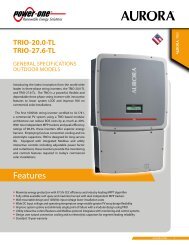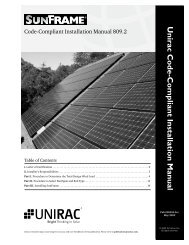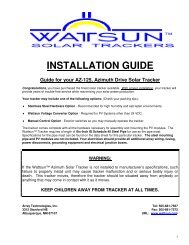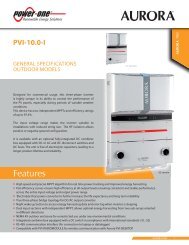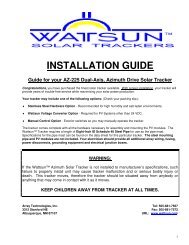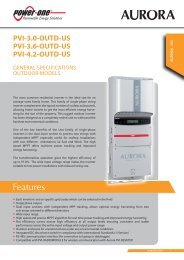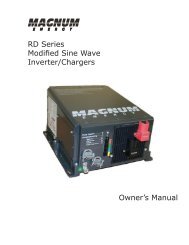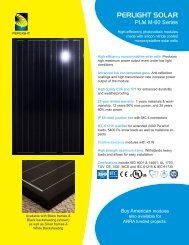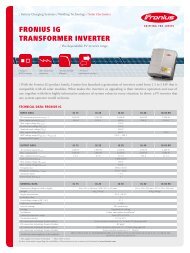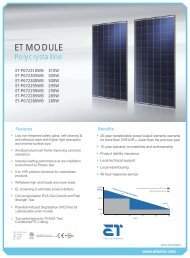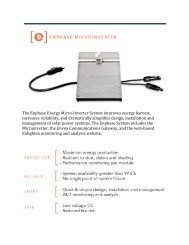MS Series Owner's Manual - Magnum Energy
MS Series Owner's Manual - Magnum Energy
MS Series Owner's Manual - Magnum Energy
You also want an ePaper? Increase the reach of your titles
YUMPU automatically turns print PDFs into web optimized ePapers that Google loves.
Installation<br />
2.4.1 DC Wire Sizing<br />
It is important to use the correct DC wire to achieve maximum efficiency from the system and<br />
reduce fire hazards associated with overheating. Always keep your wire runs as short as practical<br />
to help prevent low voltage shutdowns and keep the DC breaker from nuisance tripping (or open<br />
fuses) because of increased current draw. See Table 2-1 to select the minimum DC wire size (and<br />
corresponding overcurrent device) required based on your inverter model. The cable sizes listed in<br />
Table 2-1 for your inverter model are required to reduce stress on the inverter, minimize voltage<br />
drops, increase system efficiency and ensure the inverter’s ability to surge heavy loads.<br />
If the distance from the inverter to the battery bank is greater than 5 feet, the DC wire will need<br />
to be increased. Longer distances cause an increase in resistance, which affects the performance<br />
of the inverter. Continue to use the overcurrent device previously determined from Table 2-1 and<br />
then refer to Table 2-2 to determine the minimum DC wire size needed for various distances based<br />
on your inverter model.<br />
2.4.2 DC Overcurrent Protection<br />
DC overcurrent protection is not included in the inverter and for safety and to comply with electrical<br />
code regulations, it must be provided as part of the installation. The DC overcurrent protection<br />
device must be installed in the positive DC cable line, can be a fuse or a circuit breaker and must<br />
be DC rated. It must be correctly sized according to the size of DC cables being used, which<br />
means it is required to open before the cable reaches its maximum current carrying capability,<br />
thereby preventing a fire. In a residential or commercial electrical installation, the NEC requires<br />
both overcurrent protection and a disconnect switch. If a circuit breaker is used as the overcurrent<br />
protection device, it can also be used as the required DC disconnect.<br />
If a fuse is used as an overcurrent device, a Class-T type or equivalent is recommended. This fuse<br />
type is rated for DC operation, can handle the high short-circuit currents and has a time delay<br />
that allows for momentary current surges from the inverter without opening the fuse. However,<br />
because the fuse can be energized from both directions, if it is accessible to unqualified persons,<br />
the NEC requires that it be installed in a manner that the power must be disconnected on both<br />
ends of the fuse before servicing.<br />
Use Table 2-1 to select the DC overcurrent device needed based on the recommended minimum<br />
wire size according to your inverter model. These recommendations may not meet all local code<br />
or NEC requirements.<br />
Inverter<br />
Model<br />
12345<br />
Table 2-1, Recommended DC Wire/Overcurrent Device for Rated Use<br />
Maximum<br />
Continuous<br />
Current 1<br />
<strong>MS</strong>2012 222 amps 278 amps<br />
<strong>MS</strong>2812 311 amps 388 amps<br />
<strong>MS</strong>4024 222 amps 278 amps<br />
Using Conduit In Free Air DC<br />
NEC Minimum DC Recommended Minimum DC<br />
Grounding<br />
Current 2 Maximum DC<br />
Wire Size DC Breaker Wire Size<br />
Electrode<br />
Fuse Size<br />
(rating) 3 Size 4 (rating) 4<br />
3<br />
Wire Size 5<br />
#4/0 AWG<br />
(260 amps)<br />
#4/0 AWG<br />
(260 amps)<br />
#4/0 AWG<br />
(260 amps)<br />
250 amps 6 #2/0 AWG<br />
(300 amps)<br />
250 amps 6 #4/0 AWG<br />
(405 amps)<br />
250 amps 6 #2/0 AWG<br />
(300 amps)<br />
300 amps with<br />
time delay<br />
400 amps with<br />
time delay<br />
300 amps with<br />
time delay<br />
#6 AWG<br />
#6 AWG<br />
#6 AWG<br />
Note 1 - Maximum Continuous Current is based on the inverter’s continuous power rating at the lowest input voltage.<br />
Note 2 - NEC Current is based on the Maximum Continuous Current rating with a 125% NEC de-rating for sizing the overcurrent<br />
device (when not continuous duty) to prevent it from being operated at more than 80% of rating.<br />
Note 3 - Copper wire rated with 90°C (194°F) insulation at an ambient temperature of 30°C (86°F), with a multiple cable<br />
fill factor (0.8) de-rating (if needed).<br />
Note 4 - The next larger standard size overcurrent device may be used if the derated cable ampacity falls between the<br />
standard overcurrent devices found in the NEC.<br />
Note 5 - Per the NEC, the DC grounding electrode conductor can be a #6 AWG conductor if that is the only connection to<br />
the grounding electrode and that grounding electrode is a rod, pipe, or plate electrode.<br />
Note 6 - May not allow continuous operation at full rated power as defined by the NEC.<br />
© 2009 <strong>Magnum</strong> <strong>Energy</strong> Inc.<br />
Page 15




